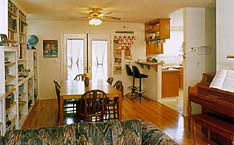|
|
"Durable, high quality finishes are critical to the long term performance of housing developments. The best way to find out what finishes and hardware to put in a specific project is to ask a property manager. They know about performance first hand and can provide invaluable insights into what works and what doesn't. And they are more than willing to help if asked. How your development looks on Day 1 is nowhere near as important as how it looks - and performs - a year later."
Rose McNulty,
Asian Neighborhood
Design, San Francisco,
California
Tools for Step 16
Print Step 16
|
|
|
Step 16. Identify and prioritize the key finishes and hardware for the project - those which are most critical to creating a project that is "built to last."
Why is this step important?
As a project proceeds through the contract documents phase, the proposed finishes and hardware for the development are often the first things to be adjusted or cut to the minimum to meet the budget. But sometimes these components make huge contributions to the quality and durability of a project. For instance, solid kitchen cabinet doors wear better and last longer than simple veneer doors. They may be more expensive, but this extra expense can be justified, for example, in kitchens that experience a lot of traffic, resulting in a lot of wear and tear on the cabinets. Substituting veneer for solid cabinet doors may save money in the short term but could cost the project more in repair and replacement costs over time.
A clear understanding of which finishes and hardware are the most important will help you more effectively manage cost-driven substitutions and/or eliminations and ensure that design quality is not compromised.
Your highest priority components will be the ones worth fighting hardest for as the inevitable process of adjustment and compromise plays itself out.
When should this step be done?
During the Contract Documents phase when the project's finishes, hardware, trim and fixtures are being specified.
Who should do this step?
The owner/developer and the design team with input from a contractor, if possible, and from the property manager.
What should be done?
- As the contract documents are being developed, a list of the project's finishes and hardware will emerge as part of the "specifications" which accompany the working drawings.
- Analyze this list and determine which materials or systems are the most critical to ensure that the project is "built to last."
- As you refine and rework the "specs" for the project to make your cost estimates fit your budget, make sure that your top priority finishes and hardware are not compromised.
- Consider favoring "public" elements, especially those which enhance the neighborhood where the project is located (for example, entry doors), over more "private" components, especially those which the occupants can maintain, repair or replace themselves (for example, closet doors).
- Print the Prioritized List of Key Finishes and Hardware Form, fill it out and add it to the Project Book.
(This list should also accompany the Contract Documents and Specifications.)
How can doing this help move my project forward?
- A clear list will help speed decision-making as final project specifications are developed.
- The final specifications that result will be strongly focused on creating a project that is "built to last."
Additional Resources
The Materials Handbook, a review of building materials and products for high density affordable housing developed by Asian Neighborhood Design of San Francisco.
|
